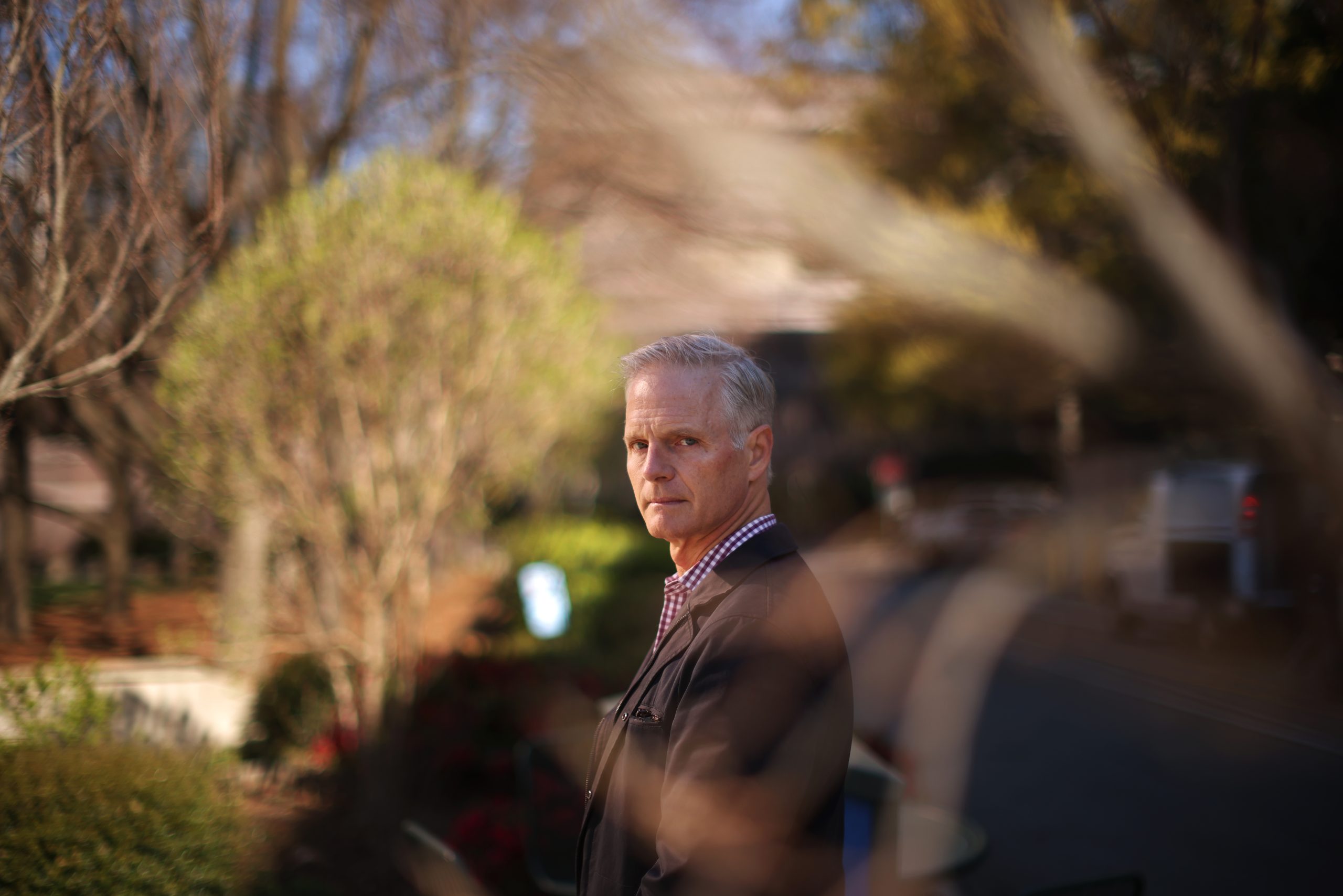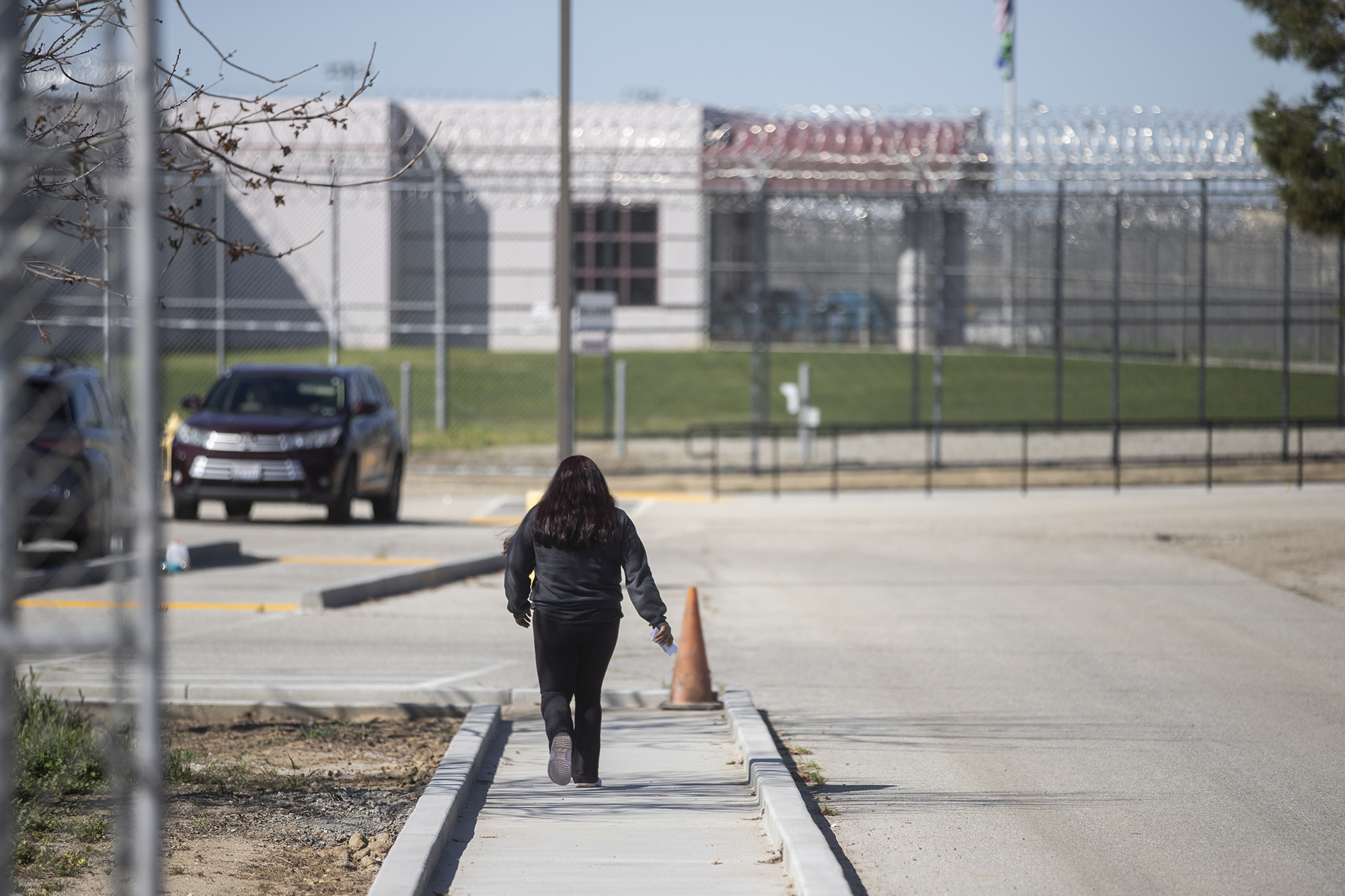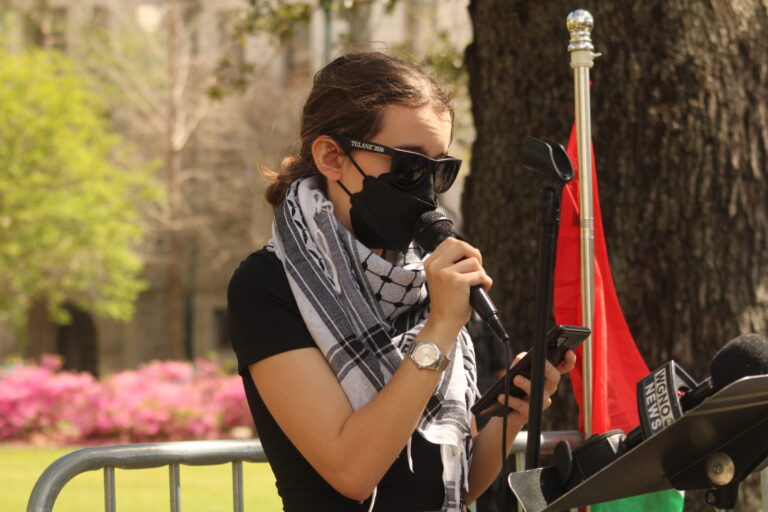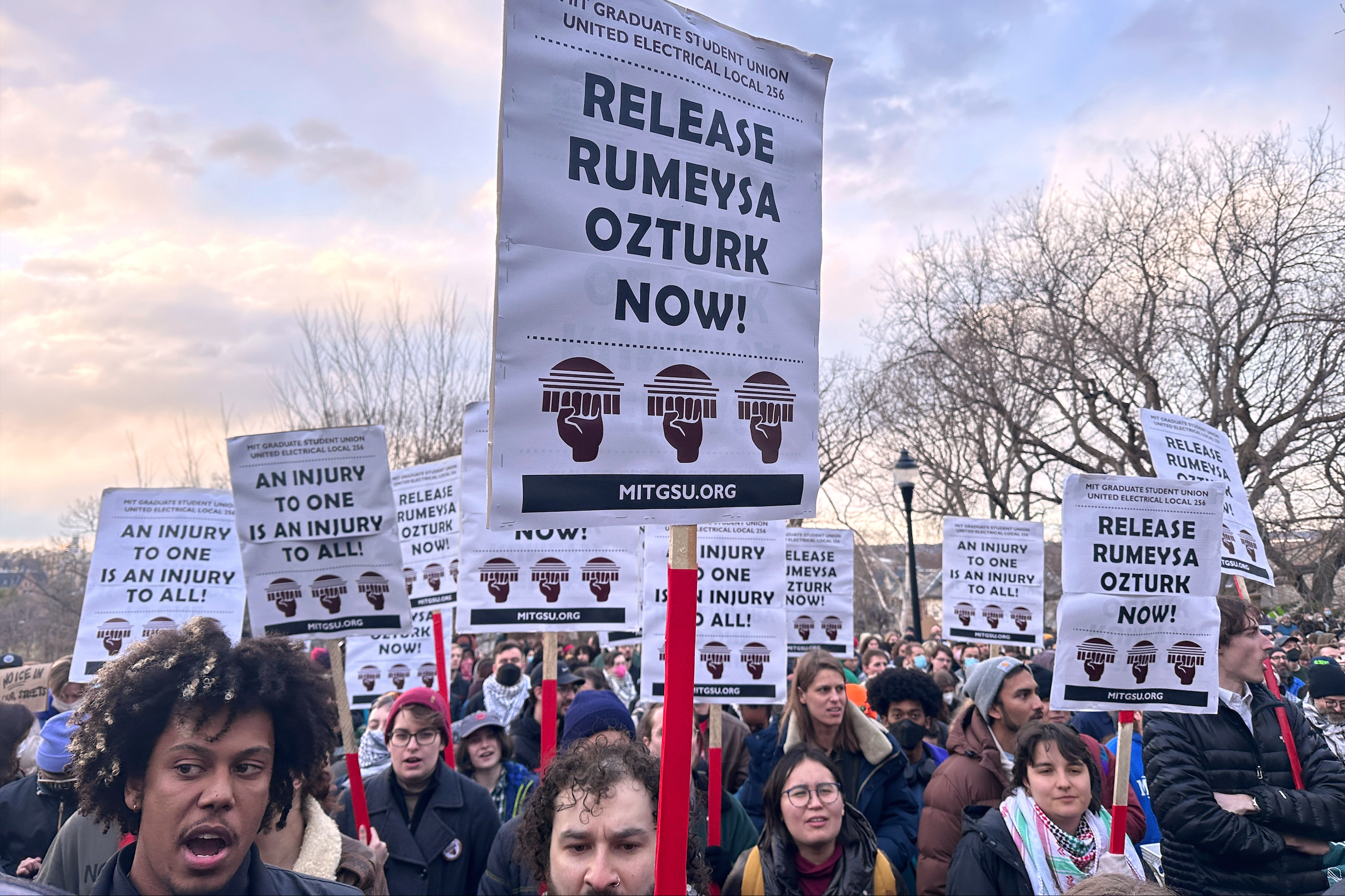Asheville’s jobless rate — North Carolina’s highest — is ‘new and unwelcome’ territory
Tulane University accuses students who participated in peaceful, off-campus protest of conduct violations

It's Friday, April 4, 2025, and in this morning's edition we're covering Asheville currently dealing with North Carolina's highest unemployment rate, over 40 people arrested at Texas home, San Francisco limits access to drug supplies, Mother of domestic violence victim hopes an appeal to the Utah Supreme Court will change state law, A Charlotte regulator's job is eliminated, reports of immigration sweeps are warping life in California’s Central Valley, Tulane accuses students who participated in peaceful, off-campus protest of conduct violations, Tufts graduate student was held in Vermont after arrest in Massachusetts by immigration agents, feds say, NYPD Stop-and-Frisks Soared in 2024, Following a central Mississippi mother’s report that her child who was allegedly raped was turned away from a hospital, lawmakers risk letting a bill that would require ERs to stock and perform rape kits die on deadline day, Partisan politics infiltrating non-partisan local Illinois elections, Oregon’s Department of Environmental Quality will soon regulate the pollution and any cleanup of six PFAS compounds known to be harmful to human health.
Media outlets and others featured in this edition: Carolina Public Press, Mississippi Free Press, Mission Local, Next City, Utah Daily Dispatch, The Assembly, CalMatters, Verite News, VTDigger, New York Focus, Mississippi Today, Capitol News Illinois, Oregon Capital Chronicle.
To continue reading the rest of each article, please click the link at the end of the excerpt.
A new resource from the State Democracy Research Initiative makes the current text of all 50 state constitutions available and searchable on one site. This was from State Court Report.
Bolts has a guide to each state's supreme court.
Months after Helene took lives and livelihoods, many Asheville residents haven’t returned to work. Some think there might be a deeper issue.
by Jane Winik Sartwell April 2, 2025
Six months later and still out of a job. That’s the reality for nearly 13,000 Asheville residents half a year after Tropical Storm Helene struck Western North Carolina.
In the wake of the historic storm, hundreds of businesses closed. The region’s multibillion dollar tourism sector took a devastating hit. Thousands of people were severed from their jobs. Many have not returned to the workforce.
Asheville, a city of roughly 95,000 people, typically boasts the lowest unemployment rate of North Carolina’s municipalities.
[Subscribe for FREE to Carolina Public Press’ alerts and weekend roundup newsletters]
But not now. Not after Helene.
As of January, the most recent figures available, Asheville had a 6% unemployment rate — the state’s highest — according to the N.C. Department of Commerce.
Clark Duncan, director of the Asheville Chamber of Commerce, calls the ranking a “new and unwelcome accolade.”
Help wanted in Asheville
Rocky Mount and Fayetteville, each hovering around 5% unemployment, are giving Asheville a run for its money.
The capital city of Raleigh is home to North Carolina’s lowest jobless rate at 3.2%.
And statewide, that number is a respectable 4%.
But Asheville’s high rate of unemployment doesn’t necessarily mean there aren’t jobs in the region, according to one expert.
“Buncombe County certainly does not have a jobs problem,” said Andrew Berger-Gross, a senior economist for the N.C. Department of Commerce. “What they have is an unemployment problem. We see employers hiring, but there is a large contingent of workers who have not returned to work.”
First, there is what economists call a “matching problem.” Meaning, the jobs that need to be filled do not match the skills and interests of the unemployed.
There are 20,000 job openings in the region, according to Nathan Ramsey, director of the Mountain Area Workforce Development Board. Sectors like health care and manufacturing are on track for normal hiring numbers. Plus, Helene actually created jobs in certain industries, such as construction and debris removal.
“You may be the best bartender in the world, the best server, the best cook — but does that mean you want to drive an 18-wheeler up mountain roads?,” Ramsey asked. “Does that mean you can do — or want to do — construction? Probably not.”
Second: Just because someone needs a job doesn’t mean they are ready or able to get one.
“It is safe to assume that a lot of those unemployed workers might be facing barriers to re-employment — like losing your home or losing your car,” Berger-Gross explained. “Frankly, some people might still be struggling with the emotional trauma of the hurricane’s destruction.
“A lot of these people may need help putting their lives back together before they are ready to return to the workforce.”
Though unemployment rates rose in Asheville and Buncombe County in winter months, the amount of open positions in the region is a positive sign for an economic rebound, as are increased retail sales and hotel occupancy.
But there are concerns that the state’s disaster unemployment program might not be working as it should.
“I get a lot of emails from folks who are kind of struggling with getting unemployment assistance,” state Sen. Julie Mayfield, D-Buncombe, told Carolina Public Press. “Either they’ve applied for it and they haven’t gotten it or they’ve been turned down because they’re back at work a little bit, but not full time.”
Mayfield is hopeful that tourists will arrive to watch wildflowers bloom across the Appalachians this spring.
But wildfires across Western North Carolina may jeopardize those plans.
Smoke signals
Closed trails and roads, mandatory evacuations and poor air quality have scared off springtime tourists and kept locals from their typical routines.
Adventure tourism businesses in the area aren’t operating, putting tour guides and other personnel out of work, said Brevard Mayor Maureen Copelof. Evacuation orders in her county were lifted early this week, but Brevard’s annual bike race — Assault on the Carolinas — was canceled due to the fires.
While most economic indicators in Western North Carolina have been trending positive, an additional natural disaster, such as these fires, threatens to stall recovery before the region can fully rebound.
There is an emotional impact of the wildfires as well. The din of helicopters above the mountains is a painful reminder of the panic and trauma of Helene. Plus, the downed trees and mangled forest floors from the storm make the blazes worse.
“Some people were really triggered by the fact that there was another threat to their home and their health on the six-month anniversary of Helene,” said Leah Matthews, a UNC-Asheville economics professor. “You have people thinking: ‘I’m just starting to rebuild this house and now I need to evacuate again.’”
In the wake of wildfire and flood, economic recovery in the mountains will require patience and a willingness to adapt. The community is wrestling with fundamental questions about its identity and future.
“The elephant in the room is that the region suffered a historic tragedy, and you can’t push rewind on the VCR of life,” Berger-Gross said. “You can’t go back to a time before the disaster hit — that is why it is a tragedy. All of us are trying to move to a better future for Asheville and for Western North Carolina more broadly. But will things be exactly like they were before the hurricane? No, they can’t be.”

More than 40 people arrested at Texas home amid Tren de Aragua investigation
"More than 40 people arrested at Texas home amid Tren de Aragua investigation" was first published by The Texas Tribune, a nonprofit, nonpartisan media organization that informs Texans — and engages with them — about public policy, politics, government and statewide issues.
Sign up for The Brief, The Texas Tribune’s daily newsletter that keeps readers up to speed on the most essential Texas news.
The Texas Department of Public Safety, working with federal agencies on a joint investigation into a Venezuelan gang, arrested more than 40 people and seized drugs after serving a search warrant on an undisclosed Hays County residence, the state agency and the FBI announced Wednesday.
A DPS and FBI news release said the warrant was executed after FBI agents “developed intelligence” earlier this week about a gathering of individuals tied to Tren de Aragua, a gang that started in Venezuelan prisons and has become a target of state and federal officials. DPS did not elaborate on how the dozens of detained people may be linked to the gang.
[What you need to know about the Venezuelan gang that Texas is targeting]
President Donald Trump’s administration has targeted the criminal organization as part of its broader vow to deport millions of immigrants. But relatives of Venezuelans who have been detained and deported elsewhere in the country say they are not gang members.
It was not clear what potential crimes authorities believe the individuals had committed to be taken into custody. State and federal prosecutors plan to review evidence obtained during the execution of the search warrant to determine potential criminal charges, according to DPS and the FBI.
DPS, the FBI, U.S. Immigration and Customs Enforcement and the Hays County Sheriff’s Office, which participated in the operation, did not immediately return requests for comment Wednesday.
It was not immediately clear where the dozens of people taken into custody are being held.
The San Antonio Police Department helped with an investigation leading up to the operation, but not with the execution of the search warrant, a department spokesperson said, declining to comment further because it is “part of a larger ongoing case.” The DPS release said several local, state and local law enforcement agencies have been investigating members and associates of the gang for more than a year.
This is a developing story.
Tickets are on sale now for the 15th annual Texas Tribune Festival, Texas’ breakout ideas and politics event happening Nov. 13–15 in downtown Austin. Get tickets before May 1 and save big! TribFest 2025 is presented by JPMorganChase.
This article originally appeared in The Texas Tribune at https://www.texastribune.org/2025/04/02/texas-tren-de-aragua-ice-sting-hays-county/.
The Texas Tribune is a member-supported, nonpartisan newsroom informing and engaging Texans on state politics and policy. Learn more at texastribune.org.
Horhn Leads Lumumba in Democratic Primary for Jackson Mayor; Race Heads to April 22 Runoff
by Shaunicy Muhammad April 1, 2025
JACKSON, Miss.—Mississippi Sen. John Horhn held a commanding lead over incumbent Chokwe A. Lumumba in the Democratic primary for Jackson mayor after voters cast their ballots Tuesday.
With 24,591 votes counted as of Wednesday morning, WAPT’s tally showed that Horhn led Lumumba with over 48% of the vote, compared to Lumumba with just under 17% of the vote; the remainder was split among 10 other candidates. Hohrn would have needed to surpass 50% of the vote to win the primary outright and avoid a runoff.
“Jackson is really ready for change. They’re ready for something different,” Horhn told reporters as the votes were still being counted Tuesday evening.
‘Making Sure That Our City Remains Our City’
Lumumba has led the capital city since his first election in 2017 but faced significant headwinds this year after being indicted on federal bribery charges. He has denied all allegations of wrongdoing.
In his second term, the embattled incumbent had a fraught relationship with the Republican Legislature and some state leaders as he stood fervently against the State of Mississippi’s attempts to usurp control of Jackson’s assets.
“This campaign is about making sure that our city remains our city,” Lumumba said in a speech to his supporters on Tuesday night, drawing cheers and applause.
“I have always wanted to be a mayor of every part of Jackson,” the mayor continued. “I admit that I love this city so much that I am going to fight relentlessly in order to make sure that everybody gets the quality of life they deserve.”
Horhn, a longtime Democratic senator who has run for Jackson’s mayoral seat multiple times, touts his close working relationships with lawmakers from both sides of the aisle and argues that he would be better able to make agreements that benefit Jackson. But like Lumumba, he has opposed State efforts to take over parts of the City.
In the Jackson Republican primary, Kenny Gee will go to a runoff against Wilfred Beal on April 22.
The general election for mayor and other municipal elections across the state is June 3.
Read More:

San Francisco limits access to drug-use supplies: Will it help — or make things even worse?
‘To the degree that restricting paraphernalia forces people back to injecting, you’ll see overdoses go up and also see infections go up’
by Kelly Waldron and Joe Eskenazi April 2, 2025
San Francisco will no longer allow the distribution of safe drug use supplies — including sterile syringes and smoking kits — unless the outfits distributing the supplies offer counseling services or connect recipients to services, the Mayor’s Office announced on Wednesday.
The city confirmed it will also allocate more money to support the treatment and counseling services these nonprofits are now mandated to facilitate in order to provide safe-use supplies.
“We have to do something differently,” said Daniel Tsai, the new director of the Department of Public Health, during a press conference at the steps of City Hall on Wednesday. “And that’s part of what’s in this policy.”
The policy will also prohibit any distribution of clean drug supplies in public spaces.
During Wednesday’s press conference, Tsai emphasized that the policy shift would not veer away from scientific evidence. “The use of sterile syringe access programs is two and a half decades of evidence-based, peer-reviewed scientific literature that has a legacy here in San Francisco. We’re not backing away from that.”
In a recent meeting with Tsai, Dr. Dan Ciccerone, an addiction expert at UCSF, said he told the health director that if fentanyl-users were diverted from smoking to injection, it would result in dire consequences.
“To the degree that restricting paraphernalia forces people back to injecting, you’ll see overdoses go up and also see infections go up,” Ciccerone said.
He felt, however, that the policy of requiring counseling is a good one — but “the devil is in the details: Can they get enough funding to create the space they need and have counselors on-site?” he asked.
“I do like creating greater linkages between harm-reduction programs and treatment programs. It might cost a bit of money, though. Hopefully they are prepared for that.”
The city actually spends very little on drug supplies — some $700,000 per the Department of Public Health, with the vast majority of that being expended on syringes. The lion’s share of the drug supplies distributed in the city are actually paid for by the state.
San Francisco can, however, impose restrictions on the distribution of even state-funded supplies, as the city funds the distribution of those state-funded supplies. Even if nonprofits found alternative means of funding the distribution of state-funded paraphernalia, the city’s position is that it could still impose its chosen distribution demands — as these nonprofits, bottom-line, receive some level of city funding.
Lydia Bransten, the executive director of the Gubbio Project, noted that the effectiveness of this policy is contingent on there being enough organizations willing and able to distribute supplies indoors. “Distribution is the lowest barrier to contact with someone who may otherwise not be accessing any kind of support,” she said. “Traditionally, that’s done on the street.”
Tsai did not specify exactly what the counseling would look like at today’s press event on the City Hall steps but said the city would require nonprofits to have “skilled resources” and use “proven clinician tools.”
“There’s ample evidence that distributing supplies in general helps to actually engage people and get them connected to treatment,” Tsai said today. “So what you see in the policy is all about that. We want to use that process of providing supplies in a more indoor controlled installed space to actually have higher quality interactions, to help someone get motivated to get plugged in to treatment and recovery.”
Other experts are cautiously optimistic that the new policy might lead to better outcomes.
“I think it is a good positive direction to increase the offers and referrals to substance-use disorder treatment from our harm-reduction programs,” said Dr. Leslie Suen, a primary care and addiction doctor at UCSF.
The new policy, effective April 30, 2025, is one prong in the mayor’s new “Breaking the Cycle” initiative aimed at tackling the city’s drug epidemic and getting people off the streets, through increased enforcement, new treatment beds and unified street teams. In January and February of this year, 118 people died of drug overdose, according to the Office of the Medical Examiner. That’s a rate of two people per day.

How Bridge-Building Transformed a South Philly Immigrant Market
Immigrant vendors at South Philly’s FDR Park are shaping a new model for informal economies — with the help of a civic intermediary who speaks their language and understands the system.
Thomas Devaney April 2, 2025
Early on Sundays at South Philadelphia’s FDR Park, the soccer teams begin to arrive with coolers, kids, and families in tow. Flanking the edge of the fields, the vendors open their tents. By midmorning, their grills are sizzling — selling tacos, pupusas, fresh cut fruit, agua fresca, memories of home.
What began as an informal extension of the weekend soccer league has grown into a distinct hub: the Latino Market, a place of food, family, and old-fashioned enterprise. At 12 vendors, the market’s size is relatively modest, but its presence signals a quiet reworking of the relationship between immigrant communities and public space in one of Philadelphia’s most dynamic parks.
Urban design has undergone major shifts, from the top-down directives of Robert Moses to the grassroots activism of Jane Jacobs. But success in formalizing the Latino Market points to an emergent model of inclusive civic planning, where a civic intermediary works alongside the community rather than directing or deferring to it entirely. At its core, the market’s evolution is a story about people — about relationships built across language, systems, and lived experience.
“I never imagined the Latino Market would ever be recognized,” said Eladio Soto, one of the founding vendors at the Latino Market, in a 2024 documentary on the market. Originally from Puebla, Mexico, he has built deep roots in Philadelphia’s food scene. Beyond his role at FDR, he owns El Mezcal Cantina, a popular restaurant in the Point Breeze neighborhood. He says, “But thanks be to God, with the help of the park director, with the help of Alvaro, we are being recognized.”
Community organizer Alvaro Drake-Cortés, a Colombian immigrant, former U.S. military liaison and South Philly educator, became the de facto translator between the vendors operating a market that was technically illegal and the city’s under-resourced Parks & Rec system.
By connecting community knowledge with institutional support, Drake-Cortés was able to recognize and uplift one of the informal economies redefining what South Philadelphia looks and feels like.
Latino growth reshaping the city
The Latino Market’s origin story begins with soccer and hustle.
The market’s development is closely tied to the immigrant soccer league, Liga Pattison, which transformed two waterlogged fields into a bustling hub for weekend matches. In a short film about the market, Eladio Soto, one of the founding vendors, comments on its unexpected beginnings: “The league started in 2000. The teams that came here were hungry. And that’s where all the ideas began.”
What started informally — vendors selling out of the backs of cars or under pop-up tents — slowly grew into a regular weekend ritual.
Read More:

Mother of domestic violence victim hopes an appeal to the Utah Supreme Court will change state law
After her daughter’s wrongful death lawsuit against the Salt Lake City Police Department was dismissed, Shauna Mayne hopes the case will ‘make a real difference in how police approach domestic violence cases’
By: Kyle Dunphey - April 2, 2025
After her wrongful death lawsuit against the Salt Lake City Police Department was dismissed last week, Shauna Mayne, the mother of a woman killed by her ex-husband in 2022, says she will appeal to the Utah Supreme Court.
There, she hopes her lawsuit will spur a change in Utah law that currently gives governments immunity in wrongful death lawsuits — a change her attorney says could result in police departments giving officers better resources and training.
“This was the expected, in fact, desired result,” said Judson Burton, Mayne’s attorney.
Mayne sued the department in March 2024, about two years after her daughter, Amanda “Mandy” Mayne, was shot by Taylor Martin, her ex-husband. In the lawsuit, attorneys argue officers should have done more to intervene when Martin showed up at Mandy Mayne’s workplace and made threats, just two days before the murder.
However, Utah law prevents lawsuits against a governmental entity for wrongful death, if that death was caused in part by an assault or battery. Now that the case has been dismissed, Burton said he’ll file an appeal with the Utah Supreme Court, with the goal of stripping the government of its immunity in these cases.
With no immunity, Burton said police departments would be forced to implement changes in how they respond to domestic violence.
“Potential liability brings about a change in behavior,” Burton said. “We’d hope that it brings about a change at a systemic level — that the police officers out there pounding the pavement, doing the hard work of trying to keep people safe, are given the resources and the training they need to properly evaluate the lethality potential every time they’re responding to a case of domestic violence.”
Martin had a lengthy rap sheet, and had made repeated threats to Mandy Mayne and her family after he returned from a one-year stint in jail, including a text to Shauna Mayne that read “your daughter will be killed,” according to court documents. Those threats were investigated by Taylorsville police.
In August 2022, just two days before the murder, Martin showed up to Mandy Mayne’s workplace and threatened her new boyfriend. As police escorted him off the property, he told officers “I’m not going back to jail. … You guys are going to kill me before you get me into those gates,” according to court documents.
Then on Aug. 17, 2022, between 4 a.m. and 5 a.m., Martin shot Mandy Mayne 14 times as she arrived at a bus stop in Taylorsville, headed to work. He then walked down the street and fatally shot himself.
In the original complaint, attorneys representing the Mayne family alleged that Martin’s behavior in the days leading up to the murder warranted more action from Salt Lake City police officers. The complaint also argues that officers missed multiple red flags that suggested Martin posed a danger to Mayne and her family. And, Mayne’s attorneys say, police failed to properly investigate witness statements, communication from Martin, and to “arrange, facilitate and provide” Mayne with services available to victims of violence.
The Salt Lake City Police Department declined to comment on the lawsuit, instead pointing to previous court filings. In a motion to dismiss the case, filed in August, attorneys for the department say the Utah Governmental Immunity Act shields governments from wrongful death lawsuits.
Read More:

A Charlotte Regulator Gets DOGE’d
Jack Cobb, a lifelong Republican with decades of blue-chip legal experience, decided to move into consumer protection last year. Then Elon Musk took a chainsaw to his agency.
by Michael Graff April 2, 2025
Jack Cobb closed his work laptop at about 8 p.m. on a cold and drizzly February night in south Charlotte and stirred up an old fashioned. He settled into his couch with a book that stretched his understanding of faith and values, Dominion, which traces 2,000 years of Christianity’s command over the Western world. Cobb was somewhere around the turn of the first millennium when his phone buzzed.
The caller was his colleague and close friend at the Consumer Financial Protection Bureau.
“You gotta be shitting me,” he said out loud. Jack’s wife, Kimberly, looked up from across the living room. They both had a pretty good hunch that by the time he hung up, Jack, a 62-year-old lawyer with a sterling resume and decades of experience, would be out of a job.
Cobb gave up a lucrative role in private practice in 2024 to take a pay cut and enter civil service. He hoped the CFPB, which aims to give ordinary consumers an advocate in disputes against larger financial institutions, would provide him a fulfilling final career chapter.
Instead he became a puppet dangling in a dizzying political production, one that left him and his colleagues struggling to answer the simple question: Do we have a job, or don’t we? The new Trump administration made it plain that it wants the agency gone, and the phone call that February 11 night only confirmed that Cobb was among those being dismissed.
Several weeks later, a federal judge ruled that the administration’s scorched-earth approach to terminations was unlawful, reinstating Cobb and thousands of others. Then last Friday, a different federal judge blocked the Trump administration from dismantling the CFPB until she rules on a lawsuit seeking to preserve the agency.
By then, though, Cobb and others with standout resumes and options faced a more personal question: Do we even want this job?
Underneath the headline-grabbing slashing and burning, a more permanent scar is forming on federal workers, including 80,000 in North Carolina. The U.S. government’s value proposition for top talent has long been that they could leave higher paying and more celebrated roles in the private sector to find a shared sense of purpose in the federal workforce.
That’s evaporating by the day in many agencies, leaving the most recruitable civil servants to choose between working for leaders who don’t value them, or wishing the government well in its future endeavors.
A Guardrail for Banks
Congress created the CFPB in response to the 2008 economic collapse, which was caused in large part by banks’ risky subprime loan practices. CFPB’s mission was to provide a guardrail against future crashes, and it became an influential enforcement arm for the public against major institutions—many Republicans and financial leaders would say too influential.
In its purest form, the CFPB would operate like this: If a bank instituted hidden fees on customers, those people could submit complaints to the CFPB, where attorneys in Jack’s department worked toward settlements to get the money back in the consumers’ hands.
The CFPB’s website says that in the last 15 years, its enforcement division had achieved $19.7 billion in principal reductions, canceled debts, and other forms of consumer relief.
Cobb loved the job. He split his time between Charlotte and Washington, and paid for his own travel and lodging for the weeks he spent up there. After nearly three decades in private practice, he felt like he was making a difference for everyday people. Whenever someone asked him to describe his work he’d tell them, “Well, I’m your lawyer.”
Read More:

Raid or rumor? Reports of immigration sweeps are warping life in California’s Central Valley
by Nigel Duara March 31, 2025
Welcome to CalMatters, the only nonprofit newsroom devoted solely to covering issues that affect all Californians. Sign up for WhatMatters to receive the latest news and commentary on the most important issues in the Golden State.
Lea esta historia en Español
Truth be told, there’s a lot of white trucks in Modesto.
White Dodge Rams, white GMC Sierras, white F150s, white Ford Transit vans, white Suburbans, white Silverados, white Chevy Colorados. So many white trucks, all of them American-made: a sure sign of danger to people who read about a January immigration raid 130 miles south and spent the next two months watching for signs of the next one.
Regardless of who’s inside, those big white trucks have become a symbol of federal immigration enforcement in the heart of California’s farm country.
“They usually show up in white trucks, that’s the first signal,” said Lorena Lara, director of organizing for the Valley Watch Network, a coalition of volunteer dispatchers and legal observers who respond to reports of immigration raids in the Central Valley. “Then we look for license plates, they’ll say DHS, or there won’t be a license plate. The trucks have big antennas, like huge, always American-made. Sometimes you can see a divider between the front and the back.
“You don’t know which truck will be immigration (enforcement). And our dispatchers will get calls, saying there are trucks in the area, even if it turns out to be construction workers or something. Families are too scared to pick up their kids (from school). They’re too scared to go grocery shopping.”
New Valley Watch volunteers learn to watch for white trucks and vans as part of their training. Those volunteers said the effect lingers: When they’re driving to the grocery store or parking at the movie theater, they can’t help but notice them. And for a moment, they’re afraid.
This is the stated intention of the Trump administration’s plan to deal with illegal immigration, part of what the president promises will be the largest deportation program in American history.
“If you are here illegally, we will find you and deport you,” said Homeland Security Director Kristi Noem earlier this month. “You will never return. But if you leave now, you may have an opportunity to return and enjoy our freedom and live the American Dream.”
While immigration enforcement agents continue to detain individual people outside of their homes or at the entrance to a Walmart, the deportation program’s larger hope is to encourage people here illegally to self-deport by creating enough fear and mistrust among immigrant communities in places like the Central Valley.
It remains to be seen whether the self-deportation plan is working.
As to whether it’s creating fear — that part is working just fine.
Read More:

Tulane accuses students who participated in peaceful, off-campus protest of conduct violations
One of the students facing discipline was also briefly detained in a separate incident after leaving their backpack unattended on campus with a sign attached to it criticizing the university’s moves away from DEI policies.
by Arielle Robinson March 29, 2025
Sign up for Verite's free newsletters and get the New Orleans news you need three times a week.
Seven Tulane University students who participated in a protest demanding the release of pro-Palestine activist Mahmoud Khalil from immigration detention could face consequences from school administrators.
The students are alleged to have committed conduct violations and face a series of administrative hearings, students and their supporters said at a news conference last week.
“[Tulane] will suppress anyone who dares to exercise their First Amendment right to condemn them,” Tulane student Cameron McLaren said at the press conference.
This latest crop of disciplinary measures from Tulane is part of a nationwide wave of discipline that student activists have been met with for their pro-Palestine activism. Student organizers from Tulane and Loyola still face discipline, including semester-long suspensions, from the encampment or other pro-Palestine-related activism.
According to emails sent to two of those students and reviewed by Verite News, Tulane investigators contend that the students are associated with a group called Tulane Students for a Democratic Society. The group was suspended as a student organization by the university last year over a different unauthorized pro-Palestine protest and is currently forbidden from operating on campus.
The group, which now calls itself Together United Students for a Democratic Society, said in response in an Instagram post that the university is repressing students who are exercising their right to freedom of speech. The group now operates off-campus under a different name, though it continues to use a logo in university colors that is identical to the one it used when it was recognized by the university.
University spokesperson Michael Strecker declined to comment on the individual student conduct charges, noting that the code of conduct applies to student actions on and off campus.
“We fundamentally respect the right to protest,” Strecker said. “However, students may be held accountable for behavior if it violates university conduct policies.”
The students deny the university’s accusations, pointing out that the group has changed its name, met off-campus and didn’t hold the March 11 protest on school property.
Atticus Pratt, one of the students involved, is facing a probe called a “major matter investigation” that could lead to suspension or expulsion. Pratt said they had faced conduct charges before for their activism.
“They want to suspend students so we can’t go on campus and we can’t organize,” Pratt told Verite News. “They want to scare us out of continuing to organize. They want to make other people known that there will be consequences for joining an organization like SDS, or for attending an off-campus protest.”
Adelaide Ritzman, another student facing conduct charges, said they believe the university is violating the First Amendment rights of students who participate in such protests.
“Tulane is trying to figure out who they can scapegoat and who they can kind of make an example of,” Ritzman said.
New Orleans-area First Amendment attorney William Most, whose law firm has been involved in some of the legal matters surrounding protests at Tulane, agrees.
“Tulane may have violated federal law in its drastically harsher treatment of pro-Palestine students as compared to other students for comparable conduct,” Most said in statement to Verite News. “And [Tulane’s police department] in particular may have violated the First Amendment in its crackdown on students based on the content of their speech.”
As the Trump administration targets immigrant students and diversity, equity and inclusion efforts in higher education, some Tulane students say the school is cracking down on student speech beyond just protests.
McLaren, another one of the seven students facing discipline, said she was arrested and briefly detained earlier this month after briefly leaving her backpack unattended in the Lavin-Bernick Center for University Life, which resulted in the evacuation of the building.
McLaren spoke up at the press conference publicizing the disciplinary allegations. She said she was walking around campus with a sign on her backpack that criticized the university’s decision to get rid of its diversity, equity and inclusion office and encouraged people not to attend Tulane because of it.
The note read: “Tulane just got rid of DEI…if you have the means, go elsewhere,” according to the Tulane Hullabaloo.
Strecker said McLaren was neither arrested nor charged.
According to Strecker, Tulane police were made aware of an abandoned backpack that had a note attached to it left on the Lavin-Bernick Center’s second floor. The university said the building was quickly evacuated due to safety concerns. University police immediately responded, investigated the event and eventually found that the backpack posed no threat and normal operations resumed after the location was deemed safe, the spokesperson said.
Tulane crime logs show that a “suspicious package” was reported in the building and that the case was closed with no further action being taken. The same website says that this term means that no further investigative action is needed.
McLaren declined further interview requests, but said in an email to Verite News that her “arrest and conduct charges are clearly politically motivated. I did not break any laws nor did I violate any conduct rules.”

Tufts graduate student was held in Vermont after arrest in Massachusetts by immigration agents, feds say
After detaining Rümeysa Öztürk at ICE’s field office in St. Albans the night of March 25, court filings show, ICE officials placed her on a flight out of the airport in Burlington.
by Shaun Robinson and Ethan Weinstein April 2, 2025
Updated at 3:26 p.m.
A Turkish graduate student at Tufts University who was detained by federal agents in Massachusetts last week — and whose case has since drawn national attention — was later taken to a U.S. Immigration and Customs Enforcement facility in Vermont and held there overnight, lawyers for the federal government said in a court filing Tuesday.
ICE officials detained Rümeysa Öztürk at the agency’s field office in St. Albans the night of March 25, court records show. Then, the next morning, officials took the 30-year-old to Patrick Leahy Burlington International Airport, where she was flown to Alexandria, Louisiana.
From there, Öztürk was transported to a detention center in Basile, Louisiana, federal prosecutors wrote in the filing in U.S. District Court for the District of Massachusetts. As of Wednesday afternoon, Öztürk was being held at the South Louisiana ICE Processing Center in Basile, according to the agency’s online detainee locator.
VTDigger obtained a copy of the court filing, which is not publicly viewable on the federal government’s online court records website, on Wednesday. The details of the filing were previously reported by several Boston-area news outlets late Tuesday.
Öztürk was first detained by masked, plainclothes agents while walking on a street near her apartment in Somerville, Massachusetts, the evening of March 25. Surveillance camera video of her arrest has since been widely published, and the incident has sparked large protests in the Boston area in recent days.
Attorneys representing Öztürk, who had been living in the U.S. on a student visa, have argued that she was wrongly targeted for exercising her rights to free speech. Last March, Öztürk co-wrote an op-ed for Tufts’ student newspaper that criticized university leaders for their response to demands that Tufts “acknowledge the Palestinian genocide” and divest from companies with ties to Israel.
Read More:

NYPD Stop-and-Frisks Soared in 2024
Officers recorded over 25,000 stops last year, a 50 percent increase over the previous year. Nine in 10 people stopped by the NYPD last year were Black or Latino.
Surina Venkat · April 2, 2025
This article was published in partnership with THE CITY.
The number of stop-and-frisks performed by New York City Police Department officers sharply increased last year, public data analyzed by New York Focus and THE CITY reveals.
Officers recorded 25,386 stops in 2024, a 50 percent increase over the previous year and the highest number since 2014. Nearly nine in 10 people stopped were Black or Latino.
Over 15,600 people were frisked during stops, a 43 percent year-over-year increase.
The spike came despite new practices adopted in January 2024 to curb unlawful stops, including trainings, audits, and reviews of body-worn camera footage.
In response to a request for comment, the mayor’s office referred New York Focus and THE CITY to the NYPD’s press office, which did not respond to an inquiry.
Stop-and-frisks, otherwise known as Terry stops, refer to the police practice of stopping and patting down the outer clothing of individuals whom cops suspect to be armed and dangerous. During these stops, police may also search individuals’ belongings.
Under Mayor Michael Bloomberg, NYPD officers stopped hundreds of thousands of individuals each year and conducted a record-high 685,724 stops in 2011. Few stops resulted in arrests, and the practice disproportionately targeted Black and Latino individuals.
NYPD stops sharply decreased in the following years. In 2013, a New York federal judge ruled that the practice was ineffectual and, as implemented under Bloomberg, violated the constitutional rights of minorities. By 2021 — Mayor Bill de Blasio’s final year in office — NYPD officers conducted just 8,947 stops.
Three years later, that number has nearly tripled under the Adams administration.
Since Mayor Eric Adams took office in 2022, stop-and-frisk incidents have risen each year and continued to disproportionately target people of color. NYPD officers recorded more than 15,000 stops in both 2022 and 2023.
A notorious “anti-crime” plainclothes unit resurrected by Adams may have contributed to those increases.
In a report released last month, attorney Mylan Denerstein, a court-appointed federal monitor, found that two specialized NYPD units — the Neighborhood Safety Teams and the Public Safety Teams — were responsible for a majority of unlawful stop-and-frisks in the first half of 2023.
Read More:

As bill requiring hospitals to perform rape kits faces uphill battle, mom reports child was turned away from ER
by Sophia Paffenroth, Mississippi Today
March 31, 2025
Update 4/1/25
Legislation that would mandate hospitals perform rape kits on rape victims who present at emergency rooms is still alive after six lawmakers reached an agreement moments before Monday night’s deadline.
Lawmakers signed a conference report that includes minor changes to original language but maintains the integrity of the legislation, according to Rep. Dana McLean, R-Columbus, who is spearheading the effort.
It’s not clear whether or not the language that was changed appeases hospitals’ concerns. Mississippi Hospital Association CEO Richard Roberson declined to comment, but has repeatedly said he supports the legislation whether or not lawmakers heed his suggestion to clarify that the state law is in line with federal law.
The conference report will now face a floor vote in the Senate and House before it can head to the governor.
Original story:
Legislation to guarantee rape victims treatment at Mississippi hospitals faces an uncertain future hours before its deadline. Meanwhile, survivors continue to be turned away in Mississippi hospitals.
Just two weeks ago, a child who was allegedly raped was turned away from an emergency room in central Mississippi, according to his mother. The child’s mother gave Mississippi Today permission to quote her without using her name.
“They just said they don’t do it there,” she said. She then drove nearly an hour to a Jackson hospital where she was able to get a rape kit for her son.
Hospitals in Mississippi are not required to perform rape kits.
Rep. Dana McLean, R-Columbus, is spearheading the effort to change that. McLean’s original bill died earlier in the session, but she revived the legislation in Senate Bill 2211, which faces several more legislative hurdles – including an 8 p.m. deadline Monday.
Meeting that deadline would mean three House conferees and three Senate conferees on the conference report would need to reach an agreement. Conferees have yet to come to an agreement as of the time the story published, due partly to a concern about the impact on hospitals.
“The needle we’re trying to thread is: everyone wants to do everything we can and need to for rape victims. I mean, who’s not for helping rape victims?” said Sen. Joey Fillingane, R-Sumrall, one of the conferees. “But, some of the language, at least at first blush, when the hospitals and their legal teams looked over them, basically said, ‘Wait a minute, y’all are trying to tell ER docs how to practice medicine inside the ER.’”
Several advocacy and law enforcement groups released a statement Sunday suggesting the Mississippi Hospital Association is “leading deceptive pushback” and attributed several claims to them that were “easily disproven.”
Mississippi Hospital Association CEO Richard Roberson refuted the press release, saying his organization has only ever expressed one concern and offered tweaks in language to make sure the bill conformed with federal law. He said MHA supports the legislation regardless of whether or not lawmakers heed his suggestions.
“We are disappointed that anyone would accuse the Mississippi Hospital Association of working against this bill,” Roberson said. “MHA has met with stakeholders and offered language to strengthen the bill so that it conforms to federal law. MHA has been and is supportive of the legislation. Any characterization that MHA has not been supportive is false. MHA will continue to support victims of sexual assault – hard stop – and we will follow the law as the Legislature deems it to be.”
Even if lawmakers file a conference report Monday night, the legislation will have a hard time passing the final hurdles of the session – due to political infighting. Since the two chambers haven’t reached an agreement for the annual budget, the session could end in a stalemate and force the governor to call a special session before July 1.
If the session ends without a budget, anything that hasn’t already been signed into law by the governor would need to be rushed through the legislative process, and it’s unlikely that lawmakers would have time to do that for all the conference reports not yet filed.
This article first appeared on Mississippi Today and is republished here under a Creative Commons license.

Partisan politics infiltrating non-partisan local Illinois elections
by Ben Szalinski and Bridgette Fox, Capitol News Illinois
March 11, 2025
SPRINGFIELD — It’s been just four months since the last election concluded, but another election is on the horizon in Illinois: the April 1 elections for school boards and municipal offices.
Though municipal and school board races in Illinois are nonpartisan, voters may see many of the same political themes that were hallmarks of races during the 2024 presidential election cycle. The Democratic Party of Illinois is applying many of the same tactics it uses in partisan elections to this year’s local races.
"We as the Democratic Party of Illinois should be defending Democratic values in every single election in nonpartisan and partisan elections alike, because all of these local offices have jurisdiction over super critical controls and we think our party has the best platform for governance,” Democratic Party of Illinois Executive Director Ben Hardin said.
The 2025 local elections are the second time that Illinois Democrats are getting involved in nonpartisan races. After recruiting more than 1,000 prospective candidates last year, the state party is supporting 270 candidates for a variety of local offices in all areas of the state.
The party trained the candidates and attached them to “coaches” experienced in running Democratic campaigns. Candidates will also be supported by a six-figure advertising campaign by DPI in the coming weeks.
"I think our voters welcome the information,” Hardin said. “They want to know, and they need to know, who the aligned candidates are.”
It’s also part of the party’s strategy to be more active year-round.
"This is how the party operates now,” Hardin said. “We are not going back to closing up shop after an even-year midterm or presidential election, lying dormant for 18 months and then coming alive again for the next even-year general election.”
Hardin acknowledged there could be some voter fatigue after November’s presidential election, but he stressed that’s why the party wants to make Democratic voters aware an election is approaching.
"These local offices, if we allow them to be uncontested, especially with the Trump administration in office, you know with our lack of control of the wheels of power in D.C., we could allow our state to start slipping to the right at the local level,” Hardin said.
For example, DPI is getting involved in the mayoral race in Aurora, Illinois’ second-largest city, where incumbent Mayor Richard Irvin and Aurora Ald. John Laesch face off. The election is the first since Irvin’s unsuccessful campaign for governor as a Republican in 2022. Hardin said that’s made Irvin an easy target for a partisan campaign.
"We’re treating Aurora like the rest of our program across the state,” Hardin said. “In Aurora, you’ve got an executive of the city who is a Republican.”
As a candidate for governor, Irvin faced numerous questions about his Republican credentials. He often avoided answering any questions about President Donald Trump or his position on abortion as he faced accusations from opponents that he wasn’t conservative enough. Irvin later co-hosted a Black Republicans event at the Republican National Convention last year.
DPI is running a direct mail program this month targeting Irvin. It also plans to reach Democratic voters in Aurora through other mail and digital outreach advertising to let voters know which candidates in the city the party supports.
Irvin’s campaign did not respond to a request for comment.
Illinois State Board of Elections records show DPI also used its resources to support Peoria Mayor Rita Ali and Calumet City Mayor Thaddeus Jones, who is also a Democratic state representative, during primary elections in February.
A full accounting of the party’s spending on municipal elections won’t be available until mid-April when reports are due to the state election authority.
Conservative influence
Jim Rule, chairman of the Tazewell County Republican Central Committee, said his group doesn’t normally get involved in “consolidated-type elections” like the Morton School Board, which has five candidates running for election — but this year is different.
Four of those candidates are affiliated with Republican groups despite school board elections being nonpartisan.
In Illinois, political parties and individuals can still support and endorse any candidates they wish.
Rule said his committee vetted and backs the four Republican-aligned candidates.
“It's important to get the right people in office,” Rule said. “Look, we've all heard the phrase ‘all good government starts locally,’ and this is a classic example of that. School boards are so, so vitally critical to have the right people on them for our kids.”
The four GOP candidates are backed by the Citizens for Morton Schools political action committee, which did not reply to a request for comment.
Rep. Bill Hauter, R-Morton, is also involved in the race. He has donated $1,000 to the group as of March 5, according to the State Board of Elections, while his campaign has provided $2,000 worth of consulting.
“I am supportive of four great candidates for Morton School Board in my hometown,” Hauter said in a statement. “They are great candidates who each have their own unique qualifications that can help Morton students, parents, teachers and taxpayers. This will be a statement election for our community.”
Rule said one of the main goals of Tazewell Republicans this election cycle is defeating Dr. Ashley Fischer, a pediatrician running for the Morton School Board whom Hauter called “too radical for the people and schools of Morton.”
Fischer said she’s an anti-bullying advocate, which includes respecting all aspects of students’ identities like race, gender and sexuality.
“We want to send a message, not only to the residents of Morton, but to the community around us,” Rule said. “That this is something that — this woke agenda — is something that we need to rid ourselves of, and it has no place in the school system, especially with young kids.”
Fischer said Republicans are trying to scare voters.
“They're basically stoking hot button topics to get a fear response out of parents, to try to get them to vote against me out of fear,” Fischer said. “I have never once brought up any policy to do with transgender children, except that I think no child should be bullied in the school, regardless of their race, orientation, medical conditions, anything. They are in that group. I don't think any child should be bullied. That is my stance.”
Fischer also criticized Republicans for their online rhetoric, which she said promotes hate.
Fischer’s advocacy has also been scrutinized by Moms for Liberty, a right-wing group that advocates for conservative curricula in schools, such as by opposing LGBTQ lessons.
Virg Cihla, chair of the Tazewell County chapter of Moms for Liberty, said his group does not endorse any candidates.
The Illinois Republican Party did not reply to request for comment about their involvement in any April 1 elections.
Capitol News Illinois is a nonprofit, nonpartisan news service that distributes state government coverage to hundreds of news outlets statewide. It is funded primarily by the Illinois Press Foundation and the Robert R. McCormick Foundation.
This article first appeared on Capitol News Illinois and is republished here under a Creative Commons Attribution-NoDerivatives 4.0 International License.

State updates hazardous substances list to include harmful forever chemicals, begins rulemaking
by Alex Baumhardt, Oregon Capital Chronicle
April 2, 2025
Oregon’s list of regulated hazardous substances is getting its first update in nearly two decades with the addition of six “forever chemicals” known to harm human health.
The Oregon Department of Environmental Quality on Tuesday announced it would add six perfluoroalkyl and polyfluoroalkyl substances, or PFAS, to the state’s list of more than 800 regulated contaminants and begin creating regulations to limit Oregonians’ exposure to them.
“We need this rulemaking to hold parties responsible for contamination and to address that contamination,” said Sarah Van Glubt, a manager in DEQ’s environmental cleanup program who is leading the rulemaking. “Otherwise, right now, everything is voluntary. We can’t require parties to test and treat for these chemicals.”.
The Environmental Quality Commission is expected to vote on adding the chemicals to the state’s list and adopting new regulations on or after May 21.
PFAS are human-made chemical chains used in products such as flame retardants, nonstick cookware and waterproof clothing that do not break down or go away naturally but instead have for decades leached into rivers and streams and contaminated soil, water and even air.
They are thought to now be in the blood of everyone in the U.S., according to research and testing from the federal Centers for Disease Control and Prevention and can lead to increased risks for cancers, heart damage, high cholesterol and birth defects, among other adverse health effects.
Suspected sources of past or ongoing PFAS pollution in Oregon include eight commercial airports that are or were required to maintain PFAS-containing firefighting foam on site, as well as 18 municipal fire training facilities near 20 of the most populous cities in the state, according to rulemaking documents from DEQ.
Officials at Portland International Airport (PDX) began testing for PFAS in 2017 in and around a firefighter training ground there. A separate PFAS investigation is ongoing at the Portland Air National Guard facility located in the southern portion of the PDX property.
The airport officials identified PFAS contamination adjacent to the nearby Columbia Slough and found PFAS-impaired fish and aquatic species. They have since switched to using PFAS-free firefighting foam and have begun initial stages of cleanup.
Oregon lawmakers are considering a bill — Senate Bill 91 — that would ban PFAS from firefighting foam used on the ground by firefighters. The Oregon Senate voted to pass the bill nearly unanimously in February, but a vote in the House has not yet been scheduled.
Other sites to potentially test for PFAS contamination include 22 bulk fuel facilities and 93 metal plating facilities in Oregon.
In 2024, the U.S. Environmental Protection Agency added several PFAS to the federal list of regulated hazardous substances, and mandated states begin testing for them in drinking water systems.
The Oregon Health Authority has identified PFAS in 35 Oregon public drinking water systems, with 24 of those exceeding the EPA’s new drinking water standards for the compounds. The state has until April 2026 to adopt the federal agency’s new PFAS standards and public water systems have until April 2029 to comply with those standards.
DEQ’s new regulations would apply to PFAS pollution in rivers, lakes, soil and groundwater but would not address potential contamination released through the air, such as when biosolids and sewage sludge containing PFAS are burned, releasing PFAS into the air, or potential PFAS contamination from those biosolids being spread on farm fields as fertilizer.
Biosolids filtered from Portland’s sewer and wastewater get heated and dried out in anaerobic digestors and sent to farms in eastern Oregon as fertilizer. The department doesn’t test those biosolids, which likely contain PFAS.
Department spokesman Antony Sparrow said the EPA is developing a risk assessment for sewage sludge that will inform future state regulations.
Van Glubt said the department is working on a strategic plan that would combine the work of DEQ’s air, water, biosolids and other teams, as well as work being done at other agencies, to deal with ongoing PFAS issues.
“This rule making really is just addressing one piece of the puzzle,” she said. “There are other issues at play with PFAS that will need to be addressed.”.
Oregon’s hazardous substances list was last updated in 2006, when environmental regulators added methane to the list.
Corrections: Eight commercial airports with the Part 139 certification are suspected sources of contamination, not 139 airports. Additionally, an earlier version of this article conflated two separate firefighting training grounds — one used by the Portland Airport and one by the National Guard.
GET THE MORNING HEADLINES.SUBSCRIBE
Oregon Capital Chronicle is part of States Newsroom, a nonprofit news network supported by grants and a coalition of donors as a 501c(3) public charity. Oregon Capital Chronicle maintains editorial independence. Contact Editor Julia Shumway for questions: info@oregoncapitalchronicle.com.
-30-














